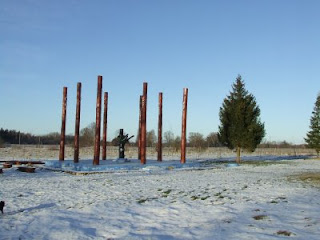
The Latvian name for John is Jānis. John-Jānis was a traveling teacher, a man who in modern India is called a sadhu. John lived off the land. He was a respected teacher and his visits were much expected. Then times changed. A young John named Jesus was seized by a gleve* of barons in the early days of writing. The barons issued their writs, which overwrote Johns teachings, and told Jesus to distribute these at the peril of his life as the word of God.
The last Jānis-John in Latvia was photographed as a beggar on Johns Day at the Rudzētu estate (muiža), in the region of Daugavpils, on June 24, 1927. A woman and a man behind Jānis wear an oakleaf crown (her shoes suggest that she is from the city), while John himself stands barefoot with a walking stick in his hands, two over-the-shoulder cloth bags filled with edibles (probably), no crown, but a cap on his head. The photo is in the LNVM (Latvijas Nacionālais Vēstures Muzejs) collection, and appears in the “Jāņu foto albums”, page 37 (center), published by Norden AB Publishing, 2007. This writer along with others made a small financial contribution to have this book see daylight.
Though writing overwrote oral history in so-called Western Europe as early as the 14th century, it reached Latvia only in the 18th century with the Hernhuter movement brought by one Graf Zinzendorf. http://www.kloster-denkendorf.de/images/Images4/Zinzendorf-Home-2.jpg Zinzendorf brought to the Latvian peasantry not only the skills of reading, but along with reading, he displaced John with Jesus. Since my earliest recorded ancestor is one Andžs (whence my nom de plume Jandžs), born in 1740, who became a Hernhuter, I have a vested interest in turning written history back to what was told by oral history—to the extent that oral truths may yet be plucked from in-between the lines of written lies of the new mythology. The last photograph of John (Latvian) is, therefore, important evidence of what happened to Latvian native religion. This religion has little to do with what we today know as “folk Gods”—Dieviņš, Pērkons, Laima, Māra, and others. This is not to say that these Gods did not exist and had no circulation in folk memory. However, they were only polysporous house Gods, who ever remained totemic symbols, and today in no way transcend them beyond a part in fairytales.
Two Gods, however, Saule and Jānis-John, remain active on the periphery of Latvian communal consciousness. These peripheral Gods (malu Dievi) have not lost their importance to the extent that they could not again move to center stage, except for being kept from moving there by lies as if sanctified by the written word, neo-Christianity, and the Latvian home-grown God known as Dievs. The latter, a prop of not only neo-Christians, but the home-grown movement known as God-holders (Dievturi) are largely responsible for the spiritual vacuum that persists in the community and contributes to its shattering. In these days, when Latvia is governed by a fake democratic government, the aforementioned—no lesser fakes—find Latvians in a situation of do-or-die. Do means to return to self-sacrifice and Jānis-John, die means to stay with passive piety and Dievs.
I have raised the issue of Jānis-John in other “topics” at LOL, especially at the site of “Latvians on Faith”, my own blogspot at http://esoschronicles.blogspot.com/ , and at this site. The Goddess Saule, in her secularized as well as spiritual context, is the special concern of the former President of Latvia, Vaira Viķe-Freiberga. I need only add that in the Latvian arch-Christian movement, the Sun, Saule, is mother, and Jānis-John is her son.
*gleve, much feared armed men on horse, knights on horse in the Middle Ages. From which the Latvian word “gļēvs”, a coward. Originally the word gļēvs suggested one who would not stand and fight with equal weapons, that is, on equal terms, therefore, cowardly.

















